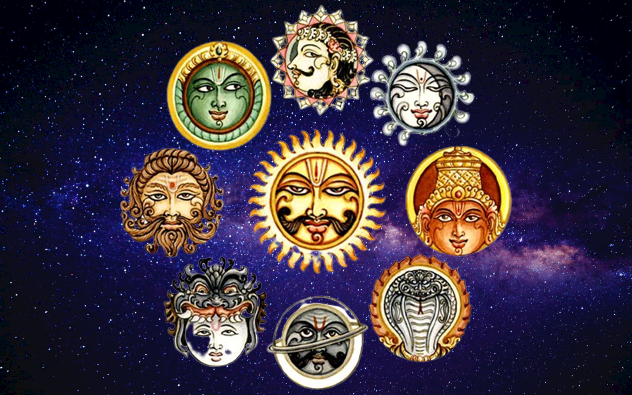Navagraha- Vedic Significance of Nine Planets In Peoples’ Life
The Navagraha is an integral aspect of Hindu astronomy and falls under its purview. The nine planets’ positions and their impact on both the Earth and an individual are central topics in Hindu astronomy, which has its roots in the Vedic period. Hindu astrology holds that a person’s potential in life is determined by the placement of the planets at the time of birth.
Collectively, the nine planets are referred to as the Navagraha. Hindus worship these nine planets to remove all difficulties, obstacles, and bad fortune. Most temples have them, and devout worshippers pray to the Navagrahas before praying to any other god.
Seven of those nine planets — Rahu and Ketu — are named after actual planets in the solar system. The other two, Rahu and Ketu, are actually devils who tricked their way into this group. Depending on where they are in the solar system, they are either lucky or bad. Even though Navagraha can be found in any temple, some of them have their own special temples. The Navagraha temple, which is situated on the outskirts of Ujjain, is one such temple.

The Impact Of Navagraha
The Navagrahas are the collective name for the nine planets. In Hinduism, they are worshipped to bring good luck or to get rid of problems, bad luck, or bad luck caused by past karma or birth defects (doshas). In most Hindu temples, they are all together on a panel or perched on a pedestal in a place where people can see them.
People usually try to make these gods happy before they pray to the main god in the temple’s holiest place. Seven of the nine gods, whose names are the same as the names of the Hindu week’s seven days, are named after planets in the solar system.
The last two deities are actually devils who, by means of deception, were able to enter the pantheon. Their names are either drawn from comets or from the two dark, potentially dangerous planets in our solar system (Neptune and Pluto). They are good or bad depending on where they are in the solar system and how they relate to the other gods.
Navagraha And Its Important In Vedic Astrology
Vedic astrology places a significant amount of emphasis on the nine planetary deities. Hindu astrologers create birth charts for people based on where they were when they were born. Depending on where they are in the astrological chart at the time, they have a positive or negative impact on people and their fates.
Shani, Rahu, and Ketu’s positions are given special consideration. Astrologers say that when the planets are in bad positions, you should do something to make them happy and lessen their effects.
Navagraha Temples
Navagraha temple is located on the banks of the river Kshipra in Ujjain, which is a well-known Saiva pilgrimage site in central India. Some temples were built just for the Navagrahas, who are worshiped as the main gods. The Navagrahas are often found in temples as minor gods.
Sometimes, temples are built for one of the Navagrahas, like the Surya and Sani temples, which can be found all over India. For example, close to Hindupur, there is a well-known Sani shrine that many followers go to. Examples seen throughout India For example, close to Hindupur, there is a well-known Sani shrine that many followers go to.
What Do Navagrahas Offer?
Vedic astrology recognizes nine planets. Nav (9), and Grahas are the names of the planets. Navgraha
- Sun (Soorya) (Soorya)
- Moon (Chandra) (Chandra)
- Mangla/Sevvai (Mars)
- Mercury (Budha) (Budha)
- Jupiter (Guru) (Guru)
- Venus (Sukra) (Sukra)
- Saturn (Shani) (Shani)
- Lower lunar node, Upper lunar node (Rahu) (Ketu)
Surya- Sun God
Surya is one of the Adityas and the main sun god. He is the son of Aditi and Kasyapa, two of Indra’s wives. He is also one of the Adityas. He has golden arms and hair. The seven horses pulling his chariot stand for the seven chakras. He rules over “Ravi-vaara,” or Sunday, in the role of “Ravi.”
In Hindu religious writings, Surya is often talked about as the everyday form of God. Also, Shaivites and Vaishnavas often see Surya as a part of Shiva and Vishnu, respectively. For instance, Vaishnavas refer to the sun as Surya Narayana. According to Shaivite theology, Surya is one of Shiva’s eight Astamurti forms.
He is thought to represent the soul, the king, high-ranking individuals, or fathers, and to be of the Sattva Guna.
Hindu texts say that Shani (Saturn), Yama (the God of Death), and Karna (from the Mahabharata) are some of Surya’s better-known children.
Chandra-Moon God
A lunar god is called Chandra. The moon, which is also called Soma, is linked to the Vedic moon god Soma. He is said to have two arms, to be young, handsome, and fair, and to hold a club and a lotus in each hand. Every night, the moon or an antelope serve as his chariot as he rides through the sky.
To read the full blog, visit: https://eastsidewriters.com/navagraha-importance-and-significance-of-nine-planets/
